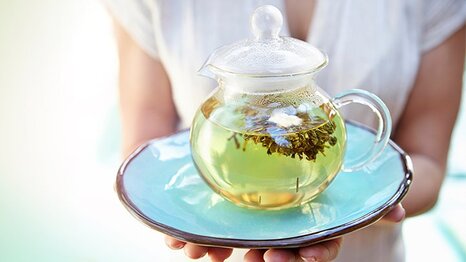 Green Tea is Touted for its Antioxidant Property Green Tea is Touted for its Antioxidant Property Tea and coffee are staple beverages in Asia, especially in our country. We love to sit down every evening with a hot flask of ‘garam’ chai and some pakoras to spend our day leisurely enjoying the cool breeze and the sunset. Tea is preferred by those suffering from a bad cold, runny nose or even helps in alleviating tiredness and sleepiness. Isn’t it common to see men and women visit the cafeteria for a cup of steaming coffee or tea every once in a while to revitalize themselves and keep the energy pumped up? Besides these, tea is also used as a medication based on experience. Of late, individuals have adopted a healthier lifestyle trying to reduce their calorie intake to stay fit and be in shape. Many of them love to sip on a mug of hot green tea which is also one of the most popular beverages in Asian countries! Green tea comes in various flavors and one is surely amazed by the variety available-herbal and flower-based green teas including chamomile, jasmine, rose, marigold, hibiscus and more have captured the hearts of people with their subtle yet impeccable flavor. Every restaurant almost has green tea in its menu alongside the regular coffee and tea. Even kids don’t mind indulging in a cup of green tea containing lemon and honey. How has the world which was once behind creamy lattes, sugary coffees and masala chai divert its attention to a watery beverage that contains nothing but the essence and flavor of the tea leaves picked from the hilly regions of cities? Green tea contains numerous polyphenols called catechins (tea leaves contain 10-20% catechins) the most popular among them including epigallocatechin gallate (EGCg), epicatechin gallate (ECg), gallocatechin gallate (GCg), epicatechin (EC) and their thermal isomers including catechin (C), catechin gallate (Cg), gallocatechin (GC) and gallocatechin gallate (GCg). These tea catechins are said to behold advantageous properties including antioxidant, anticancer, antidiabetic and antiatherogenic activities. Its been seen that consumption of green tea catechins (GTC) inhibit diet-induced obesity (DIO) in mice and also reduce body weight and visceral fat area (VFA) in humans. Some studies reveal that GTC have an anti-obesity effect by stimulating fat oxidation, modulation of adipogenesis, decreased fat synthesis, inhibition of digestive enzyme activity and nutrient absorption. There are also numerous studies whose focus on catechin’s antioxidant and anti-cancer properties showed that green tea is extremely effective against heart disease. The world is growing in size and the residents are becoming fatter paving way for an obesity epidemic. Its been shown that obesity rates have tripled since 1975, there are more than 1.9 billion adults who are overweight of which at least 600 million were obese (13% of the world’s population is obese). Excess accumulation of body fat in the abdominal region such as in the case of abdominal obesity can increase the risk of metabolic disorders. Obesity is generally classified into visceral and subcutaneous according to fat distribution. Visceral fat is the dangerous one as it lines internal organs, is an independent mortality predictor in men and plays a critical role in the development of metabolic syndrome (MetS). There are studies showing that continuous consumption of GTC-containing beverage (>540 mg/day) by obese/overweight men and women reduced body fat and visceral fat area (VFA). But we don’t have trials and studies that have evaluated the effect of continuous GTC intake on reduction MetS risk in a large study population. We might have studies showing that total fat area (TFA) along with VFA increases risk of MetS but what we lack is clear evidence as to whether reduction in VFA and TFA due to GTC intake is related to MetS risk reduction. A research team did a post-hoc pooled analyses of data that helped to understand the effect of regular GTC intake on abdominal fat reduction and MetS improvement. Post-Hoc Pooled Analysis The research team selected studies that met their different requirement criteria and finally six trials were included. A post-hoc analysis was performed in each of them. Each of the studies had a different GTC quantity and thus all the subjects were assigned to a daily dose of 540 mg/day to 588 mg/day GTC depending on their GTC amount consumed by the subjects in their respective studies. In one Japanese study people reported a huge difference in mortality rates due to consumption of at least five cups of green tea daily. Every cup of green tea contains almost 100 mg catechins and hence those who consumed at least 500 mg/day of catechins were marked as the high catechin (HC) group and those who consumed less than that were marked as the low catechin (LC) group. There were altogether 921 subjects involved from the six selected trials. Though sex, age, height, weight, BMI, waist circumference, VFA, TFA and SFA were not significantly different between groups mean GTC was 35 mg/day in the LC group, 563 mg/day in the HC group and triglyceride (TG) and fasting blood sugar (FBS) values were significantly higher in the HC group than in the LC group. 20.5% and 18.1% subjects were Pre-MetS and MetS in the LC group while in the HC group it was 21% and 20.1% respectively. Body weight and BMI were significantly lesser than baseline in the HC group; Body weight and BMI were both lower in the HC group than in the LC group. Coming to abdominal fat, TFA, VFA and SFA were lower than baseline only in the HC group and the reducing in these values were significantly greater in the HC group compared to the LC group. TG and HCL did not decrease significantly from baseline in both the groups and there was no significant difference between the two groups. FBS significantly differed from baseline in the HC group but there was no difference between the two groups. Systolic blood pressure (SBP) significantly decreased from baseline only in the HC group and also, there was greater decrease witnessed in the HC group compared to the LC group. Diastolic blood pressure (DBS) decreased significantly from baseline in the HC group but there was no difference witnessed between the groups. Subclass Analyses of Pre-MetS and MetS Individuals In order to find the effectiveness of GTC in improving obesity/abdominal fat in subjects with pre-MetS or MetS 368 subjects (218 men and 150 women) were chosen. Here, body weight, BMI, waist circumference, TFA, VFA and SFA decreased from baseline only in the HC group and also the difference was significantly more in the HC group compared to LC. FBS and SBP decreased from baseline only in the HC group, TG and HCL did not decrease from baseline in the HC group and TG alone significantly decreased from baseline in the LC group. In terms of improvement, the proportion of subjects who improved from Pre-MetS to healthy and from MetS to healthy or Pre-MetS showed improvements in 30.2% subjects in the LC group and 41.5% subjects in the HC group. Subclass Analyses Based on Changes in Abdominal Fat Accumulation in the HC Group Regular consumption of GTC-containing beverages reduced body weight and abdominal fat area while improving MetS status. The Pre-MetS and MetS subjects in the HC group were further split into two groups where the first group was those containing individuals whose consumption of GTC-containing beverage reduced TFA, VFA and SFA (reduced group) and another group where these parameters did not reduce (non-reduced group). VFA and SFA significantly reduced in the TFA-reduced group comparatively; Body weight, BMI, waist circumference, FBS and SBP decreased significantly from baseline but there was no significant difference compared to the non TFA-reduced group. TG, HDL and DBP did not see significant difference compared to baseline in either group. Improvement rate from Pre-MetS to healthy and from MetS to healthy was 23.8% in the non TFA-reduced group and 46.6% in the TFA reduced group. Subjects were once again classified into VFA-reduced and non-VFA reduced groups and their results compared. There was significant decrease in body weight, BMI, weight circumference, TFA, VFA, SFA and FBS from baseline in the VFA-reduced group but no change from baseline seen for TG, HDL, SBP and DBP. MetS improved by 18.9% in the non VFA-reduced group and by 50.4% in the VFA-reduced group. Comparison between the non SFA-reduced and SFA reduced groups showed that there was a significant reduction in FBS from baseline in the SFA-reduced group compared to non-SFA reduced group but there was no difference seen in other parameters between the two groups. The combined analysis of the six trials shows that consumption of GTC-containing beverages reduced abdominal fat accumulation, improved metabolism-related parameters and also reduced the number of subjects classified as MetS. Exercise-induced Abdominal Fat Loss in Obese/Overweight Adults A randomized, double-blind study was conducted to evaluate the effects of green tea catechin-containing beverage on body composition and fat distribution in overweight and obese adults. Participants were chosen based on several criteria: healthy, sedentary individuals aged between 21 and 65 years having a waist circumference ≥87 cm (in women) and ≥90 cm (in men). All the participants were put into one of the two groups-the control group or the active beverage group where each person received 500 mL/d (contained 63 kJ of energy and 250 mg of sodium) of some beverage providing ~625 mg catechins. All of them were asked to drink one 500 ml bottle daily within 30 min anytime of the day with or without food. All the participants were instructed to increase their activity to ≥180 min/week of moderate-intensity activity and attend at least 3 supervised exercise sessions per week. Though the study included 128 participants 21 of them did not complete the study due to several reasons. Mean BMI was 32 and mean age ~48 years. Results showed that:
Efficacy of Tea Catechin-rich Beverages to Reduce Abdominal Adiposity and Metabolic Syndrome Risks in Obese and Overweight Subjects: https://www.sciencedirect.com/science/article/pii/S0271531717305444 Green Tea Catechin Consumption Enhances Exercise-Induced Abdominal Fat Loss in Overweight & Obese Adults: https://academic.oup.com/jn/article/139/2/264/4750912 A Green Tea Extract High in Catechins Reduces Body Fat & Cardiovascular Risks in Humans: http://citeseerx.ist.psu.edu/viewdoc/download?doi=10.1.1.1032.4079&rep=rep1&type=pdf Comments are closed.
|
AVOID FRAUD. EAT SMART+91 7846 800 800
|
- Home
- Written Testimonials
- Consult
- Clinics
- Blogs
-
Diet & Nutrition
- Diabetes Reversal
- IVF IUI not needed for PCOS PCOD Infertility
-
Medical Nutrition
>
-
Disease & Conditions
>
- Infertility | PCOS
- Diabetes Mellitus
- Cholesterol
- Hypothyroid
- Kidney Problems
- Hypertension
- Cardiovascular Diseases
- Liver Diseases
- Gastro intestinal disorder
- Cancer
- Metabolic Disorders
- Orthopedic Disorders
- Eating Disorders
- Dietary Recall
- Weight Record Filled By Clients
- Online Payment Transaction Details
- Online Clients Weight Check Form
- Our Program Package Service Charges
- Weight Record 2017 Clients
- Measurements sent by Clients
- Terms & Conditions Of Payment
- Thanks. Your Form is Submitted
- Video Testimonials
- Lifestyle & Wellness
- Lifestyle & Wellness Blog
- Allergy & Intolerance
- Weight Loss / Gain
- Weight Loss / Slimming Blog
-
Disease & Conditions
>
- Life Cycle Nutrition >
- Sports Nutrition >
- Integrity in Nutrition
- Knowledge Centre
© COPYRIGHT 2022. ALL RIGHTS RESERVED. FRST HEALTHCARE PVT LTD.
Dr. Nafeesa Imteyaz of First Eat Right clinic, is the Best Dietitian Nutritionist in Bangalore. Best Dietitian Nutritionist in Pune. Best Dietitian Nutritionist in Hyderabad. Best Dietitian Nutritionist in Chennai. Best Dietitian Nutritionist in Mumbai. Best Dietitian Nutritionist in Delhi. Best Dietitian Nutritionist in Kolkata.



